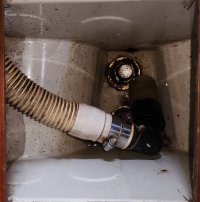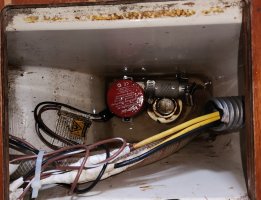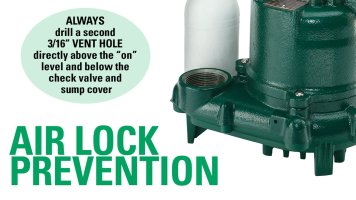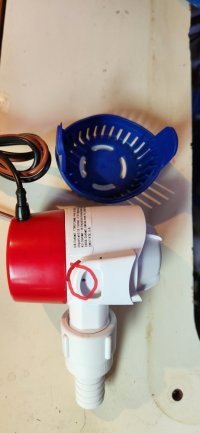I think any diaphragm pump, like the Whale manual pump, has check valves built in.
-
Untitled Document Join us on April 25th, 7pm EDT
for the CBEC Virtual Meeting
EY.o April Zoom Meeting
All EYO members and followers are welcome to join the fun and get to know the people you've met online!
See the link below for login credentials and join us!
(dismiss this notice by hitting 'X', upper right)
You are using an out of date browser. It may not display this or other websites correctly.
You should upgrade or use an alternative browser.
You should upgrade or use an alternative browser.
Factory original bilge pumps in 32-3
- Thread starter peaman
- Start date
peaman
Sustaining Member
Correct. The diaphragm moves back and forth only to create the negative/positive pressure pulses, while a pair of check valves keep those pulses moving in the right direction. It is possible to push fluid right through a diaphragm pump, but only in the correct direction.I think any diaphragm pump, like the Whale manual pump, has check valves built in.
Right. Neither the diaphragm nor the centrifugal pump would, by itself, need a check valve. It's the Tee in the plumbing that requires it. Without it, the Rule can pump the wrong way through the Tee--i.e., out the open hose end that serves as the Whale Gulper pickup--rather than out the end connected to a through-hull (see the drawing in post #95).I think any diaphragm pump, like the Whale manual pump, has check valves built in.
Trickdhat came up with the brilliant idea of eliminating the Tee altogether and just letting the Whale pump suction through the open body of the Rule pump. That's so clever I'd have to give it a try. It might be restrictive though; the Rule pump's outlet size (at 1-1/8") is 44% smaller than the 1-1/2" hose the Whale uses.
If that is too restrictive, then what? I'd still find a way to eliminate the check valve (it renders a pump inoperative whether it gets stuck open or closed). Other options:
1. Unlikely, I'm guessing, that you'll find a centrifugal pump with a 1.5" outlet that will fit in the bilge.
2. Keep the Tee, but:
a) replace the check valve with a simple ball valve
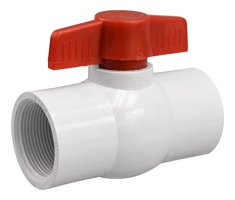
or, b) ditch the check valve and just keep a threaded nipple and cap on the Whale's intake while it's not in use.

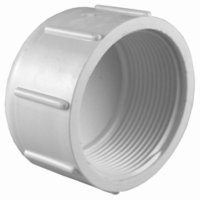
Also, hang a tag on the Whale pump handle that says "Open Y-valve and remove end cap (or, open ball valve) before pumping."
Never a "perfect" solution, but any of these beats tearing through the hull, sole, and TAFG to install a second 1.5" hose and thru-hull.
Last edited:
Filkee
Sustaining Member
Okay, I go from feeling smart to not so smart and then it keeps me up at night. To reset, I have two Rule 500 Automatic (cycling) pumps. The previous owner wired them toget her and they share the switch in the head. They fry fuses constantly. They are evacuating markedly different sized spaces and I think they just push/pull each other into overheating. So since I put two batteries under the settee next to the mast, I thought let’s just start fresh and wire the pumps to the batteries that are close by and give them individual switches so they don’t trouble each other anymore. But then I realized that I can’t put the switch right there because they’re not ignition protected and wiring them in the same compartment where the batteries are is just bad kitty. Is there a way I could enclose the back side of the switch to protect it sufficiently from the battery space so as not to inadvertently blow myself up before sinking? Seal the back of the switch with a plastic box? Swallow a spider to catch a fly?
I hadn't thought about protecting against igniting hydrogen off gassing from batteries. I always thought ignition protection was for equipment in gas engine compartments. My switch isn't in the same compartment as the battery, but technically the battery compartment isn't isolated from non ignition protected equipment either.Okay, I go from feeling smart to not so smart and then it keeps me up at night. To reset, I have two Rule 500 Automatic (cycling) pumps. The previous owner wired them toget her and they share the switch in the head. They fry fuses constantly. They are evacuating markedly different sized spaces and I think they just push/pull each other into overheating. So since I put two batteries under the settee next to the mast, I thought let’s just start fresh and wire the pumps to the batteries that are close by and give them individual switches so they don’t trouble each other anymore. But then I realized that I can’t put the switch right there because they’re not ignition protected and wiring them in the same compartment where the batteries are is just bad kitty. Is there a way I could enclose the back side of the switch to protect it sufficiently from the battery space so as not to inadvertently blow myself up before sinking? Seal the back of the switch with a plastic box? Swallow a spider to catch a fly?
Norwester
Member II
To all those who provided input, images and imagination on Bilge Pumps these past few years, the benefits are paying off for us newbies with old boats. Thank you! Whether sticking with the Rule suck or Jabsco push, new Ericson owners have a bucket load of resources and experience, due to your extraordinary contributions, to help them improve upon existing systems or completely refit their (plumbing or any) systems.
New words/phrases learned (Cool stuff!):
LIMBER HOLE: "a drain hole through a frame or other structural member of a boat designed to prevent water from accumulating against one side of the frame, and allowing it to drain toward the bilge.")
STRUM BOX; "a perforated metal box fitted around a bilge suction pipe opening to prevent debris from choking the pipe"
Of course, there have been a few bilge related threads/blogs... some of note:
@vanilladuck addressed the issue of air locks...and work arounds with newly manufactured RULE pumps https://ericsonyachts.org/ie/thread...ng-airlock-on-a-rule-800-w-check-valve.20548/
I'll second the "priming hole" phenomena that ole' timers will use on sump pumps, and second the idea that RULE manufacturers would rather new owners not see or hear water squirting back into the bilge owners were trying to dry out. However, that's apparently how these pumps function best to alleviate airlock... as does our home's ZOELLER sump pump: https://zoellerpumps.com/video/airlock-prevention/
@Nick J , on their E35, is an eye-opening project on bilge hose replacement...ARGH!: https://ericsonyachts.org/ie/threads/bilge-hose-replacement-battle.20284/
Have to thank @bsangs for reviving the thread, which made me look again at my recently repaired and "functioning" bilge water evac system. Well, turns out that important improvements should be made (current stats pics attached):
1. Add additional switch to existing ONE in system.
2. Add audible alarm for warning of high water. (Purchased AQUALARM 20038 Smart Switch) NOTE: They have switch 20090 WITHOUT alarm at $49ish. Rodney at company can help you out. Thanks @Kenneth K for install ideas.
3. Contain water collected from mast to just forward bilge bay to reduce total volume of water inadvertently flowing through LIMBER HOLES throughout the vessel's bilge (perfect idea @Kenneth K ... no wonder why your other bilge bays are so spotless)
4. Test Whale hand pump and make inspection to determine if replacement valve kit out to be purchased.
5. Replacing and increasing number of hose clamps.
...but this discussion also got me thinking...
Question: Considering the stories I've read about PSS failures, back flows, through hull failures and the like...dockside, why not have a primary AC pump readily available, mounted, switched and ready to help? Basically...why are AC bilge pumps just not in use? (wiring and water?)
New words/phrases learned (Cool stuff!):
LIMBER HOLE: "a drain hole through a frame or other structural member of a boat designed to prevent water from accumulating against one side of the frame, and allowing it to drain toward the bilge.")
STRUM BOX; "a perforated metal box fitted around a bilge suction pipe opening to prevent debris from choking the pipe"
Of course, there have been a few bilge related threads/blogs... some of note:
@vanilladuck addressed the issue of air locks...and work arounds with newly manufactured RULE pumps https://ericsonyachts.org/ie/thread...ng-airlock-on-a-rule-800-w-check-valve.20548/
I'll second the "priming hole" phenomena that ole' timers will use on sump pumps, and second the idea that RULE manufacturers would rather new owners not see or hear water squirting back into the bilge owners were trying to dry out. However, that's apparently how these pumps function best to alleviate airlock... as does our home's ZOELLER sump pump: https://zoellerpumps.com/video/airlock-prevention/
@Nick J , on their E35, is an eye-opening project on bilge hose replacement...ARGH!: https://ericsonyachts.org/ie/threads/bilge-hose-replacement-battle.20284/
Have to thank @bsangs for reviving the thread, which made me look again at my recently repaired and "functioning" bilge water evac system. Well, turns out that important improvements should be made (current stats pics attached):
1. Add additional switch to existing ONE in system.
2. Add audible alarm for warning of high water. (Purchased AQUALARM 20038 Smart Switch) NOTE: They have switch 20090 WITHOUT alarm at $49ish. Rodney at company can help you out. Thanks @Kenneth K for install ideas.
3. Contain water collected from mast to just forward bilge bay to reduce total volume of water inadvertently flowing through LIMBER HOLES throughout the vessel's bilge (perfect idea @Kenneth K ... no wonder why your other bilge bays are so spotless)
4. Test Whale hand pump and make inspection to determine if replacement valve kit out to be purchased.
5. Replacing and increasing number of hose clamps.
...but this discussion also got me thinking...
Question: Considering the stories I've read about PSS failures, back flows, through hull failures and the like...dockside, why not have a primary AC pump readily available, mounted, switched and ready to help? Basically...why are AC bilge pumps just not in use? (wiring and water?)
Attachments
Yeah, I think that the main reason is that AC and water don't mix--unlike 12V DC, it can kill you.Question: Considering the stories I've read about PSS failures, back flows, through hull failures and the like...dockside, why not have a primary AC pump readily available, mounted, switched and ready to help? Basically...why are AC bilge pumps just not in use? (wiring and water?)
Other reasons: DC pumps are available with any almost any (reasonable) high-level output you could desire. And, why not install something that is still useful once you leave the dock.
I did install a temporary AC pump during the 6-days I had to wait for a haul-out after I blew my PSS. I still store the pump (and a hose) on the boat, but I never considered making it a permanent installation.
Last edited:
Norwester
Member II
Project Update/Complete for 2025
Feeling better now with pump redundancy and alarm in place.
New shower Rule 500 GPH sump/bilge pump...with hole (pic)
New AQUALARM 20038 Smart Switch with alarm.
New hose and thru-hull/TAFG fittings at shower drain hole and shower sump/bilge.
New BlueSeas bilge man/auto switch in head.
Total: $175ish. plus hours learning, cleaning, renewing connections of existing Rule 800, testing, wiring, caulking.
Future: Ensure positive source wiring connected at battery, rather than 12V panel "bilge" switch to ensure pumps ALWAYS have access to power (Will not be turning 12V panel switch to OFF for some time.).
Pics and more here under @Kenneth K blog on this subject.
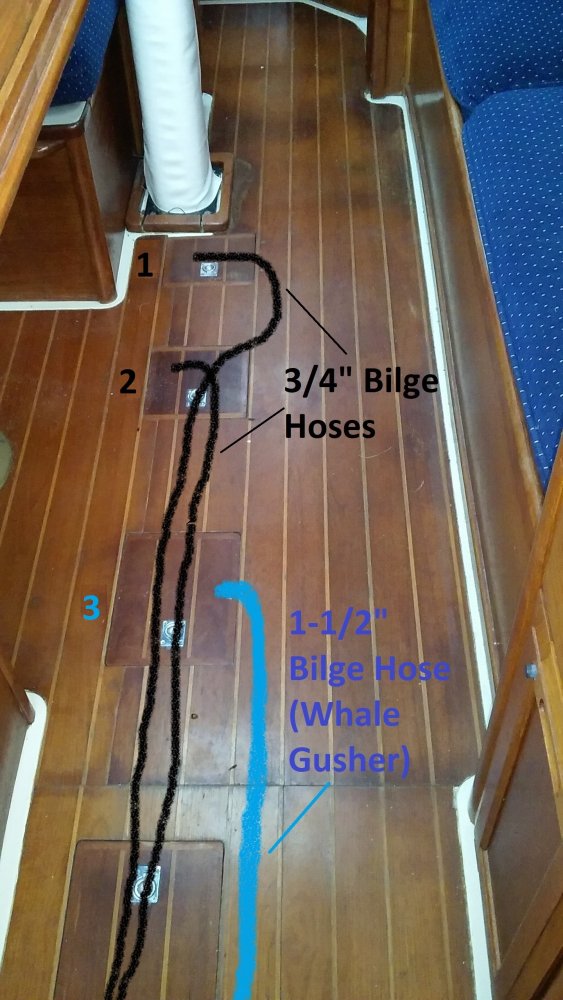
 ericsonyachts.org
ericsonyachts.org
Keep your limber holes cleaned out (Just had to make fun with new words in my vocab.)
(Just had to make fun with new words in my vocab.)
Feeling better now with pump redundancy and alarm in place.
New shower Rule 500 GPH sump/bilge pump...with hole (pic)
New AQUALARM 20038 Smart Switch with alarm.
New hose and thru-hull/TAFG fittings at shower drain hole and shower sump/bilge.
New BlueSeas bilge man/auto switch in head.
Total: $175ish. plus hours learning, cleaning, renewing connections of existing Rule 800, testing, wiring, caulking.
Future: Ensure positive source wiring connected at battery, rather than 12V panel "bilge" switch to ensure pumps ALWAYS have access to power (Will not be turning 12V panel switch to OFF for some time.).
Pics and more here under @Kenneth K blog on this subject.
E32-3 - Re-working the Bilge Pump Setup
I just re-did my bilge pump configuration on Mariah for the third time. I keep playing with ways to handle the forward or “mast” bilge, which constantly overfills with water during the Seattle winter. The layout of my 32-3 bilges, as I inherited...
Keep your limber holes cleaned out

